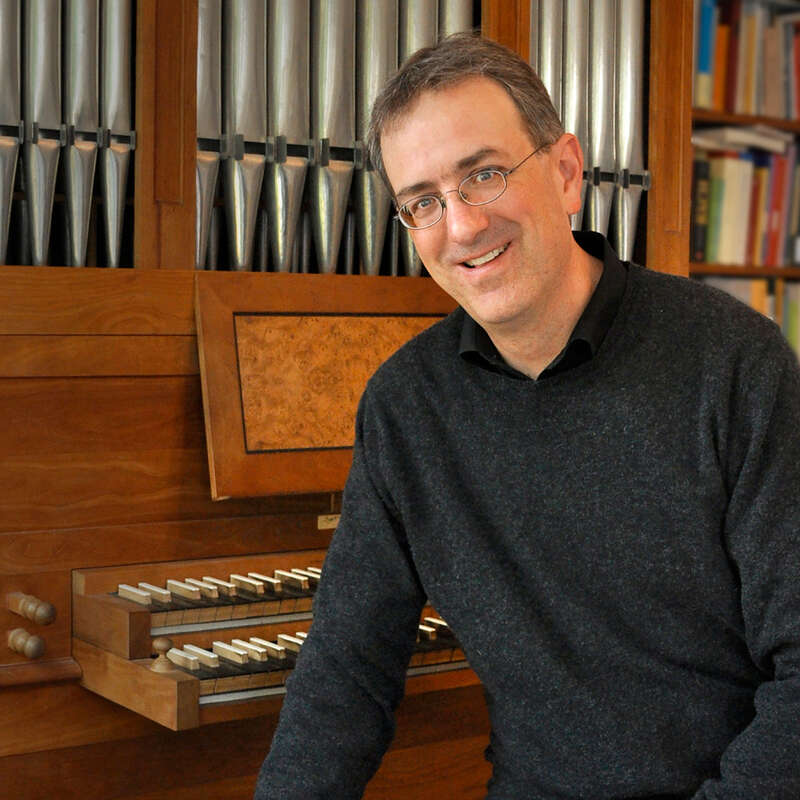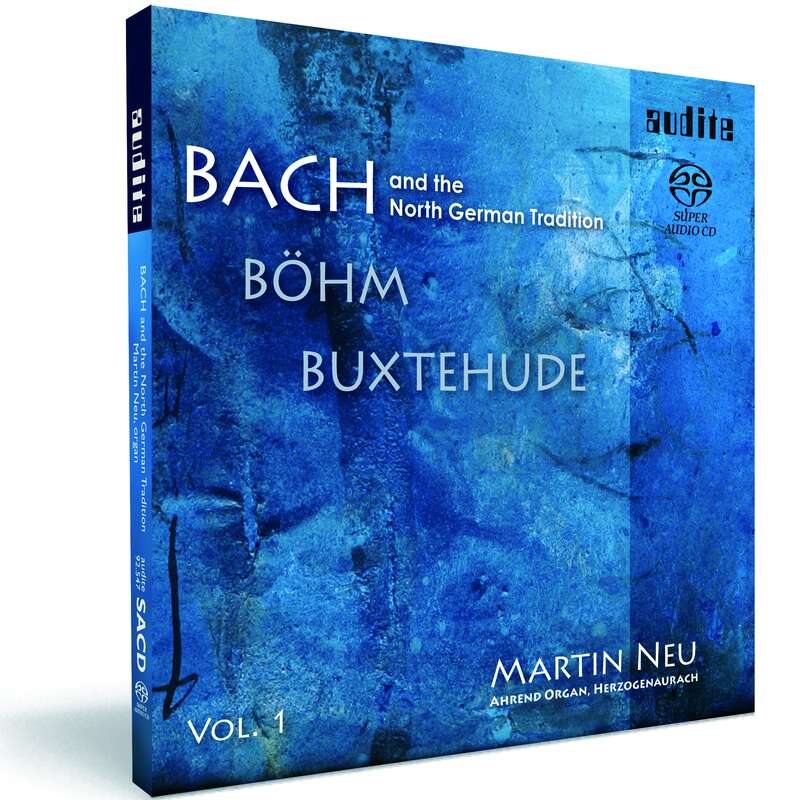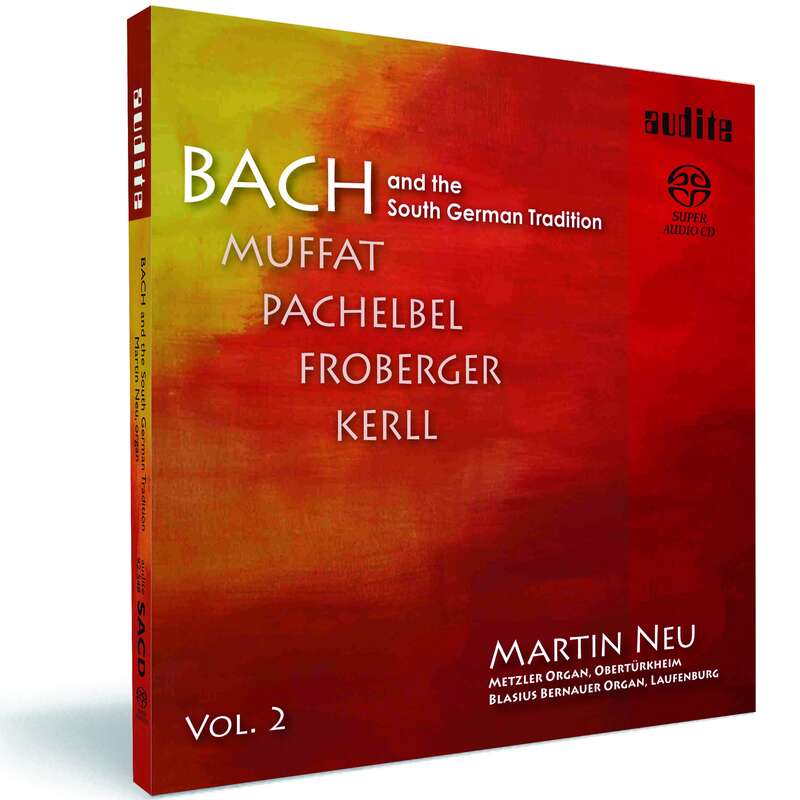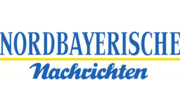This series impressively documents, on two SACDs, the influences of both North and South German composers on the organ works of Johann Sebastian Bach. Whereas contrasting his compositions with works of Georg Böhm and Dieterich Buxtehude especially shows the influences of North German masters onmore
"Martin Neu hat auf einem modernen Instrument Beispiele der Vorbilder und Bachs erhellend einander gegenübergestellt; demnächst soll ein Album zur süddeutschen Tradition folgen." (Falter)
Track List
Multimedia
Informationen
This series impressively documents, on two SACDs, the influences of both North and South German composers on the organ works of Johann Sebastian Bach. Whereas contrasting his compositions with works of Georg Böhm and Dieterich Buxtehude especially shows the influences of North German masters on Bach's early works, the second part of the series points out reminiscences of Bach's organ works in selected compositions of South German composers, including Johann Jakob Froberger, Johann Caspar Kerll, Georg Muffat and Johann Pachelbel. In addition, the historical performance practice of Magnificat prayers is realised here: works of Pachelbel and Bach are newly combined, including Magnificat verses sung according to the traditional sequence and combined to form a musical unity.
Reviews
Organ | 02/2013 | Axel Wilberg | February 1, 2013
Neu spielt mit sicherem Zugriff, klarer Artikulation und festem Tempo. Stilsicherheit und technische Souveränität seines Spiels stehen außer Frage. Mehr lesen
Fono Forum | Mai 2012 | Friedrich Sprondel | May 1, 2012
Wege zu Bach
Bach nahm so viele Einflüsse in seine Orgelmusik auf, dass sich einem neugierigen Interpreten viele Wege zu ihm auftun – und manche Aufnahme zeigt, dass auch noch neue zu begehen sind.
Die Britin Margaret Philips bringt ihre Bach-Gesamteinspielung in Doppelfolgen heraus; jede Scheibe ist dabei einem prominenten Instrument gewidmet.Mehr lesen
Das kann auch für den Leipziger Thomasorganist Ullrich Böhme gelten. Zuletzt hat er sich die großen Orgelchoräle vorgenommen, die Bach in seinen späten Leipziger Jahren in einer Sammelhandschrift zusammenfasste. Jedem Choral stellt Böhme einen Bach'schen Choralsatz voran, gespielt auf der kleinen Hildebrandt-Orgel von 1723 in Störmthal, einem kraftvoll-herben Instrument, das Bach bekannt war. Den jeweiligen Orgelchoral – oder die zugehörige Werkgruppe – spielt Böhme dann auf der großen "Bachorgel" der Leipziger Thomaskirche, die Gerald Woehl im Bachjahr 2000 fertigstellte. Beide Instrumente wurden mit vorteilhafter Direktheit aufgenommen und die farbenreiche, klangmächtige neue Orgel kann neben der charakterstarken alten gut bestehen. Ein Vergnügen aber ist, zu erleben, wie die "Bachorgel" den Thomasorganisten offenbar inspiriert. Er artikuliert und registriert, bei straffen Tempi und absoluter Klarheit, mit umwerfender Spielfreude. Die höchst anspruchsvolle Sammlung wird in ihrem stilistischen Reichtum unmittelbar erlebbar: als packende Musik.
Martin Neu möchte in seinen beiden Einspielungen Bach aus der Perspektive der nord- und süddeutschen Orgelkunst des 17. Jahrhunderts sichtbar machen. Er hat sich stilistisch adäquate Instrumente ausgesucht: Die Ahrend-Orgel in Herzogenaurach überzeugt mit warm-artikuliertem Klang und gibt dem norddeutschen Repertoire – hier beschränkt auf Bachs unmittelbare Bekanntschaften Böhm und Buxtehude – lebhafte Farbigkeit; beim süddeutschen – Kerll, Muffat, Froberger und Pachelbel – nutzt Neu die intensiv strahlende Metzler-Orgel in Obertürkheim für Pedaliter-Kompositionen, die Bernauer-Orgel in Laufenburg von 1776 mit ihrem satt-obertönigen Klang für die Manualiter-Musik. Hörbar inspiriert vom lebendigen Klang der Instrumente, spielt Neu stilistisch angemessen, übertreibt weder Tempi noch Artikulation und registriert oft betont schlicht, aber dank charaktervoller Einzelstimmen musikalisch sehr ergiebig. Die suggerierte Abhängigkeit begründet Neu im Booklet-Text einleuchtend; doch wird vor allem deutlich, wie stark Bach das Aufgenommene jeweils um- und sich anverwandelte.
Carsten Wiebusch geht einen Schritt weiter, indem er sich vornimmt, Bach gleichsam durch die Ohren eines anderen zu präsentieren: Er hält sich an die Ausgaben, die der Brahms-Zeitgenosse William Thomas Best mit Spielanweisungen für den modernen Konzertorganisten und seine technisch fortgeschrittene Orgel versehen hatte. Wiebusch präsentiert damit jene Klangressourcen, die die Klais-Orgel der Karlsruher Christuskirche hinzugewann, als sie kürzlich renoviert wurde. Dabei wurde die schlanke Sechziger-Jahre-Disposition um romantische Farben erweitert, die sich in der gelungenen Aufnahme durch große Intensität nachdrücklich bemerkbar machen. Schärfe und Fülle zusammen ergeben eine expressive Klangpalette, die Wiebusch nutzt, um den Best'schen Interpretationen dramatisches Profil zu verleihen – auch den Überraschungen, die in pièces de résistance wie der Passacaglia und der d-Moll-Toccata auf den Hörer warten. Dabei spielt Wiebusch selber überaus charakteristisch: Er meidet schwülstiges Romantisieren, artikuliert deutlich und lässt auch über die Tempobeugungen hinweg den rhythmischen Fluss nie abreißen. Wiebuschs Bach holt sich letztlich bei W. T. Best die Lizenz für ein expressiv gesteigertes Bach-Spiel – das als solches zweifellos überzeugt.
Fono Forum | Mai 2012 | Friedrich Sprondel | May 1, 2012
Wege zu Bach
Bach nahm so viele Einflüsse in seine Orgelmusik auf, dass sich einem neugierigen Interpreten viele Wege zu ihm auftun – und manche Aufnahme zeigt, dass auch noch neue zu begehen sind.
Die Britin Margaret Philips bringt ihre Bach-Gesamteinspielung in Doppelfolgen heraus; jede Scheibe ist dabei einem prominenten Instrument gewidmet.Mehr lesen
Das kann auch für den Leipziger Thomasorganist Ullrich Böhme gelten. Zuletzt hat er sich die großen Orgelchoräle vorgenommen, die Bach in seinen späten Leipziger Jahren in einer Sammelhandschrift zusammenfasste. Jedem Choral stellt Böhme einen Bach'schen Choralsatz voran, gespielt auf der kleinen Hildebrandt-Orgel von 1723 in Störmthal, einem kraftvoll-herben Instrument, das Bach bekannt war. Den jeweiligen Orgelchoral – oder die zugehörige Werkgruppe – spielt Böhme dann auf der großen "Bachorgel" der Leipziger Thomaskirche, die Gerald Woehl im Bachjahr 2000 fertigstellte. Beide Instrumente wurden mit vorteilhafter Direktheit aufgenommen und die farbenreiche, klangmächtige neue Orgel kann neben der charakterstarken alten gut bestehen. Ein Vergnügen aber ist, zu erleben, wie die "Bachorgel" den Thomasorganisten offenbar inspiriert. Er artikuliert und registriert, bei straffen Tempi und absoluter Klarheit, mit umwerfender Spielfreude. Die höchst anspruchsvolle Sammlung wird in ihrem stilistischen Reichtum unmittelbar erlebbar: als packende Musik.
Martin Neu möchte in seinen beiden Einspielungen Bach aus der Perspektive der nord- und süddeutschen Orgelkunst des 17. Jahrhunderts sichtbar machen. Er hat sich stilistisch adäquate Instrumente ausgesucht: Die Ahrend-Orgel in Herzogenaurach überzeugt mit warm-artikuliertem Klang und gibt dem norddeutschen Repertoire – hier beschränkt auf Bachs unmittelbare Bekanntschaften Böhm und Buxtehude – lebhafte Farbigkeit; beim süddeutschen – Kerll, Muffat, Froberger und Pachelbel – nutzt Neu die intensiv strahlende Metzler-Orgel in Obertürkheim für Pedaliter-Kompositionen, die Bernauer-Orgel in Laufenburg von 1776 mit ihrem satt-obertönigen Klang für die Manualiter-Musik. Hörbar inspiriert vom lebendigen Klang der Instrumente, spielt Neu stilistisch angemessen, übertreibt weder Tempi noch Artikulation und registriert oft betont schlicht, aber dank charaktervoller Einzelstimmen musikalisch sehr ergiebig. Die suggerierte Abhängigkeit begründet Neu im Booklet-Text einleuchtend; doch wird vor allem deutlich, wie stark Bach das Aufgenommene jeweils um- und sich anverwandelte.
Carsten Wiebusch geht einen Schritt weiter, indem er sich vornimmt, Bach gleichsam durch die Ohren eines anderen zu präsentieren: Er hält sich an die Ausgaben, die der Brahms-Zeitgenosse William Thomas Best mit Spielanweisungen für den modernen Konzertorganisten und seine technisch fortgeschrittene Orgel versehen hatte. Wiebusch präsentiert damit jene Klangressourcen, die die Klais-Orgel der Karlsruher Christuskirche hinzugewann, als sie kürzlich renoviert wurde. Dabei wurde die schlanke Sechziger-Jahre-Disposition um romantische Farben erweitert, die sich in der gelungenen Aufnahme durch große Intensität nachdrücklich bemerkbar machen. Schärfe und Fülle zusammen ergeben eine expressive Klangpalette, die Wiebusch nutzt, um den Best'schen Interpretationen dramatisches Profil zu verleihen – auch den Überraschungen, die in pièces de résistance wie der Passacaglia und der d-Moll-Toccata auf den Hörer warten. Dabei spielt Wiebusch selber überaus charakteristisch: Er meidet schwülstiges Romantisieren, artikuliert deutlich und lässt auch über die Tempobeugungen hinweg den rhythmischen Fluss nie abreißen. Wiebuschs Bach holt sich letztlich bei W. T. Best die Lizenz für ein expressiv gesteigertes Bach-Spiel – das als solches zweifellos überzeugt.
Organists' Review | March 2012 | Nicholas Johnson | March 1, 2012
This SACD release from Audite formst he second volume of a collection focusing on composers, mostly documented by C.P.E. Bach, crowned with repertoireMehr lesen
Much of the music is recorded at 2005 Metzler organ in Stuttgart – Obertürkheim. This splendid organ is first heard in organo pleno for Bach’s Toccata in F, BWV 540. A compelling performance, although slightly lacking in forward movement.
Organist Martin Neu shows affinity with the style and his articulations are very convincing. The tempo choices in the more rapid toccatas of Muffat and Pachelbel are particularly fine together with stylish registrations (they can be found on line!) Neu always avoids the tendency to rush the toccatas. He really comes alive in the Trio Sonata no. 5 in C major, BWV 529, this being my favourite of his performances.
A pleasing touch is the addition of tenor Wilfried Rombach, whose shapely performance of the plainsong Magnificat verses sets Pachelbel’s Magnificat in context of its performance at the Nuremburg Church of St Sebald. Pachelbel’s final organ interpolation is lost and the addition of Bach’s own Fugue on the Magnificat, BWV 733, as the Gloria Patri is master stroke of programming.
Bach’s Fugue in F major, BWV 540, forms a dramatic conclusion to this most enjoyable recording, so thoughtfully conceived and executed. A few unsteady moments, but I thoroughly recommend this CD.
American Record Guide | 01.03.2012 | William J. Gatens | March 1, 2012
This is the second disc from organist Martin Neu illustrating the stylistic connections between the organ works of JS Bach and German composers of theMehr lesen
If Jan Pieterszoon Sweelinck was the dominant influence on the North German school, his southern counterpart was Girolamo Frescobaldi. As young men in the service of the court of Vienna, both Froberger and Kerll were granted financial support to study with Frescobaldi in Rome. In the early 1680s, Muffat studied in Rome with Bernardo Pasquini, who was much influenced by his close study of Frescobaldi’s works. Pachelbel meanwhile absorbed the influence of Frescobaldi through his studies with Kerll. Bach was familiar with the works of these composers and Frescobaldi himself, and this was an important source of the Italian influence found in his own organ works.
The program opens with Bach’s Toccata in F, so notable for its canonic writing over a sustained pedal—common in Pachelbel’s toccatas. The double fugue in F that is usually linked with Bach’s toccata was probably composed independently. It concludes the program. Muffat is represented by one of the toccatas in his important publication Apparatus Musico-Organisticus (1690). These consist of a sequence of short sections that vary in texture and tempo.
Pachelbel’s fugues on the Magnificat were intended to be performed in alternation with the singing of verses from the canticle. A complete suite would consist of six fugues, but Pachelbel’s autograph is lost, and surviving manuscript copies do not contain complete suites. For this performance a suite has been compiled from fugues in a Berlin manuscript copy; and for the final fugue in the Doxology, JS Bach’s Fugue on the Magnificat (S 733) is used, though it is based on the Tonus Peregrinus rather than the First Tone. For this performance the intervening verses are sung by tenor Wilfried Rombach. Kerll’s toccata, like those of Muffat, consists of several contrasted sections, while Froberger’s Capriccio in F displays the unmistakable character of the Italian canzona.
The greater part of the program is played on the 2005 Metzler organ at St Francis Church, Stuttgart-Obertürkheim. It is an instrument of two manuals and pedal with 25 stops. In a brief essay, Andreas Metzler explains that the organ is essentially baroque, but with no attempt to copy a particular historical instrument or style. “Instead, we attempted to realize a baroque idea in a new and personal manner.” The result is extraordinarily attractive as heard on this recording. The full plenum is brilliant but not strident—a major achievement for any builder. Neu plays the Bach Fugue in F on full organ with the 16- foot Bourdon of the Hauptwerk and chorus reeds. On many organs—including some historical ones—this would produce a chaotic jumble of sound, but here Bach’s intricate contrapuntal argumentation is distinctly audible from start to finish. The quieter registers are also very attractive. On hearing the opening movement of Bach’s Trio Sonata in C, I thought the music might sound more cheerful with a lighter and more delicate registration. Neu’s detailed registrations are not printed in the booklet, but they can be obtained in PDF format on the Audite website. On consulting that, I am not sure he could have found a better combination for the movement.
The earlier pieces by Kerll and Froberger are played on the historic organ at St John’s Church, Laufenburg, Switzerland. It is a singlemanual instrument with eight stops built in 1776 by Blasius Bernauer. As one might expect, its tone does not have the heft of the Metzler, but it too is attractive and well suited to the music.
Martin Neu’s performances are a delight. It is refreshing to hear early organ music treated as music, not just so many historical artifacts subjected to brittle and dispassionate playing in the name of historical performance practice. Neu is never anachronistically self-indulgent, but he displays great sensitivity to the flow and phrasing of the music and chooses registrations that suit its character, especially in the multi-sectional toccatas. In each of Pachelbel’s Magnificat fugues, the registrations capture the character of the verses represented.
Fanfare | Jerry Dubins | February 1, 2012
The album title given in the above headnote is a bit confusing. Volume 2 suggests this is a second release of Baroque organ works by composers of aMehr lesen
This is primarily a disc of organ music, but according to Martin Neu’s informative booklet note, Pachelbel’s fugues to the Magnificat were composed as organ versets for a Vespers service in which the Magnificat’s verses were performed alternately by the cantor and the organ. The present recording offers a more or less—in reality, less than more—realization of such a performance, calling upon tenor Wilfried Rombach to chant or intone the alternating verses. I say “less than more” because a 1651 description of the procedure by Sigismund Theophil Staden, organist at the Nuremberg Church of St. Lorenz, gives an account in which a choir of boys was also involved in alternating with the organ and cantor.
On the disc, Bach’s Fugue on the Magnificat comes at the end of Pachelbel’s work, taking the position of the “Gloria Patri,” so it too features a bit of chanting by Rombach. Why Pachelbel didn’t provide for this last verse himself is not explained by Neu, but I gather that he decided Bach’s fugue made a fitting conclusion and simply tacked it onto the end. There’s no indication of any actual connection between Pachelbel’s Magnificat and Bach’s fugue.
The rest of the program is pretty standard Baroque organ fare. Muffat’s Toccata sexta is the sixth number in a set of 12 toccatas composed and collected under the title of Apparatus musico-organisticus. Johann Caspar Kerll (1627–1693) is represented by one of his surviving keyboard works, the Toccata I. Today, Kerll is recognized mainly as a composer of organ music and an important forerunner of Bach, but much of his music, including 11 operas and many of his vocal works, are lost.
Johann Jakob Froberger (1616–1667) was regarded in his day as Germany’s leading keyboard virtuoso, organist, and a composer whose influence extended far and wide. Generally credited with being the father of the keyboard suite, he is represented on the current disc by his Capriccio XII.
The Bach works are familiar, the Trio Sonata in C Major, being No. 5 from his set of six trio sonatas for organ, BWV 525–530. The Toccata and Fugue in F Major, BWV 540, may not have reached the staggering number of recordings—some 300!—of the Toccata and Fugue in D Minor, BWV 565, but with over 50 of its own it hasn’t gone begging. Neu splits the toccata and the fugue apart, presenting the toccata on the first track of the disc and the fugue on the last.
Two different organs are used for the recording, and they’re both beauties. The Froberger and Kerll pieces are performed on the historic choir organ by Blasius Bernauer (1776) in Laufenburg, Switzerland, while the remaining works are played on the new Metzler organ (2005) in Stuttgart-Obertürkheim. Specifications for each instrument are given in the booklet.
The recording is nothing short of magnificent, and Martin Neu demonstrates more than ample technique and musical intelligence in the application of his organs’ stops and registrations. I must make note, however, of just one issue regarding the accompanying booklet, and it’s something I’ve mentioned once or twice in the past, though I don’t recall if it was in connection with this particular label. The booklet’s paper has been treated with some chemical that stinks to high heaven. It’s probably not toxic to inhale, but if you’ve ever experienced the odor emanating from a mill that processes wood pulp for paper products, you’ll know the sickening smell I’m describing. Setting the booklet business aside—and I mean as far aside as possible—Neu’s Audite SACD is strongly recommended for excellent playing and superior recording.
International Record Review | February 2012 | David Newsholme | February 1, 2012
This release by Audite is the second volume to feature Bach's organ music played by Martin Neu (the first was reviewed by Marc Rochester in AprilMehr lesen
Neu uses two different organs: the choir organ by Blasius Bernauer at Laufenburg in Switzerland and a modern instrument, conceived in Baroque style by Metzler in 2005 at Stuttgart-Obertürkheim. Brief information is given about both instruments in the accompanying booklet and for further information, including details of the registrations used on this recording, we are helpfully directed to the company's website. Perplexingly there is no indication in the booklet about which organ was used for which pieces or the reasons why. However, it is fairly easy to discern when listening to the disc; both pitch and temperament vary (the earlier pieces by Froberger and Kerll are both played at Laufenburg and the remaining works on the Metzler at Obertürkheim). Tenor Wilfried Rombach makes an appearance on the recording, taking the traditional role of the cantor as he very capably sings alternate versicles of Pachelbel 's Magnificat versets.
Evidently, Neu views these recordings as informative documents; he writes in the accompanying programme notes that it is possible 'to clarify trends and offer an insight into existing interrelations [between Bach's music and that of the South German tradition]'. A glance at the track list reveals that the pieces are evidently chosen for the potential of direct comparison; there are three toccatas, one each by Kerll, Muffat and Bach himself. Additionally there are pieces based on the Magnificat by Pachelbel and Bach. Bach's setting is deliberately placed after Pachelbel's series of versets; we are told that it 'thus takes the position of the "Gloria Patri" which, according to Sigismund Theophil Staden, should stand 'mighty within the work'. However, it is clear that the interrelationships between the various pieces played on the disc are far more various and further-reaching than similarity of genre or melodic theme. Neu explores the similarities in compositional approach in his lucidly written notes, immaculately translated into English by Viola Scheffel. This is a programme that has clearly been well planned and researched.
Bach's Toccata and Fugue in F have been split and placed at either end of the disc; as Neu explains, they were probably written independently of each other and so there is justification for this approach. His performance of the Toccata glitters, featuring nimbly executed ornamentation in every register. One wonders whether the use of the pedal reed through the lengthy pedal points is perhaps a little overwhelming in terms of balance. However, this shouldn't overshadow an otherwise very musical performance which demonstrates much poise, especially in some of the more agile pedal passages. The Fugue, a majestic double fugue, is played with a great sense of expansiveness without becoming ponderous, allowing the various polyphonic strands to be easily discerned by the listener.
Neu's renditions of the first and final movements of the trio sonata in C are lively, which befits the music. The tempos chosen work well; they are sprightly without being too fast for the generous acoustic of the building. The central movement is played steadily and with great musical integrity especially with regards to Neu's sensitivity of phrasing. In contrast, he chooses an upbeat tempo for the Magnificat Fugue, enabling the music to gather momentum leading towards the fabulous sounding of the subject in the pedal part at the work's conclusion.
Of the other works played here, the two performed on the historical organ at Laufenberg stand out. Kerll's Toccata is executed with a fine sense of clarity without sounding over-fussy and there is a good sense of forward movement in the passagework. Froberger's Capriccio is played with a suitable lightness of approach to articulation and using sprightly tempos, ensuring that the dance character of the music comes across to the listener. Undoubtedly both works benefit from performance on the Laufenberg instrument, with Neu exploiting the delicate and varied resources available to him. The change from one instrument to another and back again mid-disc feels slightly unusual when one listens to the recording as a continuous programme, though this should not be counted as a particular drawback. This is a fascinating, well-executed release that is recommended to anyone with an interest in music of this period.
Choir & Organ | January/February 2012 | David Ponsford | January 1, 2012
This programme is framed by Bach's Toccata & Fugue in F, well played on a 2-manual Metzler (2005). Other Bach works include the Magnificat and TrioMehr lesen
Heidenheimer Zeitung am Sonntag | 21.12.2011 | Otto Paul Burkhardt | December 21, 2011 Kurz vor Torschluss
Reutlingen/Region. Keine Hektik. Auch für Kurzentschlossene hält unsereMehr lesen
Reutlinger Generalanzeiger | 16.12.2011 | akr | December 16, 2011
Orgelmusik der Barockzeit
Annäherung an eine Musik-Epoche
Natürlich ist Bach der große Monolith, andererseits ist es gerade auchMehr lesen
Badische Zeitung | Samstag, 3. Dezember 2011 | Johannes Adam | December 3, 2011
Martin Neu (Orgel)
Bach, staubfrei
Auf dieser Novität werden Bach und die süddeutsche Tradition beleuchtet (der englische CD-Titel aber wirkt da doch ein bisschen überkandidelt). DerMehr lesen
Der Sonntag - Wochenzeitung für die Evangelisch-Lutherische | Nr. 48 (27. November 2011) | Michael Klein | November 27, 2011 Einfluss der süddeutschen Barockmeister auf Johann Sebastian Bach
Namen wie Muffat, Pachelbel, Froberger und Kerll sind eher der älterenMehr lesen
Glaube + Heimat - Mitteldeutsche Kirchenzeitung | Nr. 48 (27. November 2011) | Michael Klein | November 27, 2011 Einfluss der süddeutschen Barockmeister auf Johann Sebastian Bach
Namen wie Muffat, Pachelbel, Froberger und Kerll sind eher der älterenMehr lesen
Gramophone | February 2011 | Malcolm Riley | February 1, 2011 Bach and the music that influenced him, played on a fine Bavarian organ
Although Bach gets top billing (being alphabetically top of the class), the most pleasurable highlights are the three delightful pieces by Georg BöhmMehr lesen
Crescendo Magazine | mise à jour le 18 novembre 2010 | Alain Derouane | November 18, 2010
Ce disque présente des œuvres de Johann Sebastian Bach (Prélude deMehr lesen
www.ResMusica.com | 21 octobre 2010 | Frédéric Muñoz | October 21, 2010 La découverte d’un nouvel orgue de l’atelier Ahrend
Lorsque l’on feuillète la liste des orgues construits à neuf ouMehr lesen
www.classicalcdreview.com | 01.09.2010 | September 1, 2010
Audite's SACD Bach and the North German Tradition is the first volume in aMehr lesen
Organists' Review | August 2010 | Martin Clarke | August 1, 2010
Bach and the North German Tradition:
Böhm and Buxtehude
This interesting disc demonstrates Bach 's place in the North German tradition of organ composition, in particular his relationship with Böhm, whoMehr lesen
www.classicalmusicsentinel.com | July 2010 | Mark Kravchenko | July 10, 2010
A recording like this does not come about by chance. A combination of theMehr lesen
Kirchenmusikalische Mitteilungen für das Erzbistum Paderborn | 2010/2 | Krane | July 1, 2010
Bach und die norddeutsche Tradition
Martin Neu an der Ahrend-Orgel in St. Otto, Herzogenaurach
Der Name Ahrend wird im Orgelbau seit über 50 Jahren vor allem mitMehr lesen
Württembergische Blätter für Kirchenmusik | 4/2010 Juli/August | Tilman Jörns | July 1, 2010 Bach and the North German Tradition
Ganz ehrlich, so lautet tatsächlich der Titel dieser neuenMehr lesen
kirchmusik.de | Sonntag, 27. Juni um 17:10 Uhr | Rainer Goede | June 27, 2010
Die neue Orgel von Hendrik Ahrend besticht durch ihre klare prägnanteMehr lesen
RBB Kulturradio | Klassik-Diskothek am Freitag, 4. Juni 2010 um 20:04 Uhr | Karl-Dietrich Gräwe | June 4, 2010 Martin Neu an der Ahrend-Orgel Herzogenrauch
Ein neues, aber großartiges Instrument, ein kompetenter Interpret, und ein klug ausgewähltes Programm zum Thema "Bach und die norddeutscheMehr lesen
lexnews.free.fr | Édition Semaine n° 26 - Juin 2010 | Philippe-Emmanuel Krautter | June 1, 2010
Bach est souvent considéré comme le point de référence de la musiqueMehr lesen
Choir & Organ | May/June 2010 | Douglas Hollick | May 1, 2010 Organ CDs - Bach and the north german tradition Vol. 1
These discs provide an interesting contrast of playing styles. Kynaston plays the large late 18th-century organ in Amorbach Abbey, with a more recentMehr lesen
Kynaston's recording is reissued from 1994, a fine sound if sometimes lacking in clarity. This is recognisably English playing, and none the worse for that, with a Passacaglia & Fugue starting quietly and with lots of stop changes. Indeed the impression of the disc as a whole is of someone used to using a sequencer! He is at his best musically, and with less fussy registration, in the C minor Fantasia & Fugue (BWV 537) which is given a fine performance. A worthwhile curiosity is Reger's arrangement of Bach's harpsichord Chromatic Fantasia & Fugue, using the full resources of this organ to great effect.
Winters is more period-style conscious, but often in a highly mannered and sometimes rhythmically disorganised way. The organ sounds gorgeous, but apart from one chorale prelude and the principal choruses of the preludes and fugues his registrations never get beyond 8ft and 4ft, leaving one wishing for more colour. The Vivaldi-Bach D minor Concerto is perhaps the most satisfying work here, and unlike Kynaston Winters uses exactly the registrations Bach asks for in the short opening section. Unfortunately the idiosyncrasies of his playing rule out a recommendation.
Neu is playing the smallest organ, but conjures the greatest range of colour – often ravishingly beautiful. Hendrik has learned his craft well from his father Jürgen. Here we have not just Bach, but also Buxtehude and Böhm, and two chorale partitas of the latter provide a feast of organ sounds. His playing is stylistically aware, sensitive to the individual works, and the programme is thoroughly enjoyable and strongly recommended.
The Organ | May - July 2010 No 352 | Curtis Rogers | May 1, 2010
In this programme, Martin Neu shows what a close connection there was in the genres and style used by these great masters of Baroque organ music, BachMehr lesen
Glaube + Heimat - Mitteldeutsche Kirchenzeitung | Nr. 15 11. April 2010 | Michael Klein | April 11, 2010 Reizvoller Kontrapunkt
Johann Sebastian Bachs Orgelkunst fußt auf den beiden großen VorbildernMehr lesen
Reutlinger Generalanzeiger | Freitag, 9. April 2010 | Armin Knauer | April 9, 2010 Das Dreigestirn Bach, Böhm, Buxtehude
In der Barockzeit entwickelt sich Norddeutschland zu einem wichtigenMehr lesen
International Record Review | April 2010 | Marc Rochester | April 1, 2010
Prompted by C. P. E. Bach's assertion (in his 1775 letter to Forkel) that his father 'loved and studied' the music of, among others, Froberger,Mehr lesen
It's not just the programme which does that; and, to be fair, his own booklet note suggests that the choice of programme is governed more by theological than musical considerations (although quite where Buxtehude's Passacaglia or Böhm' s Capriccio fit into the theological picture escapes me). Neu's own playing emphasizes the differences starkly. While with Buxtehude he adopts the practice, much currently in vogue, of underlining the improvisatory nature of the works by means of generous rhythmic and metrical freedom, with Bach he adopts a rhythmic rigour which, even in that most Buxtehudian of works, BWV 532, rarely runs out of phase with the metronome. He approaches Böhm a little closer to the manner in which he plays his Bach, and there is a wonderful sense of purpose in the two large sets of chorale variations; but, while he does try to forge a link between the Capriccio and the Fugue of BWV 532, apart from the fact that they are both in D major and have a lively mien, I don't readily hear any connection, not least since the Böhm was intended for harpsichord rather than organ.
In isolation, though, I derive huge satisfaction from everyone of Neu's performances. Indeed, I'd say these are some of the most rewarding performances of any of these pieces currently available on disc, the Bach works brilliantly paced while the unashamed virtuosity of Buxtehude's three pieces is conveyed with sparkling flamboyance. It helps, too, that this new Ahrend organ is such a splendid vehicle for this music. It's an object-lesson in how, in organ design (as in so much else in life), less is best, for barely two dozen stops offer just about every sound and effect we could want. The sheer vitality and colour of the instrument is best revealed in the Böhm Freu dich sehr, o meine Seele variations, and all Neu's registrations are mapped out (although not particularly clearly) in the booklet. A somewhat drainpipe quality to the pedal Trompetenbass is the only thing which doesn't quite fit, giving a faintly ridiculous air to the Bach Fugue.
In short, then, Martin Neu comes up with some very good performances indeed, all of which are well worth hearing on their own terms, the organ is one of the sweetest and most attractive I've heard on disc for a while, and the Audite SACD recording is of the highest quality, mixing a nice sense of comfort with a vivid presence. Yet the sum of the parts doesn't add up; as aural evidence of the link between Bach and his 'north German icons', this misses the mark by a mile.
Wochen-Kurier | 24. März 2010 Nr. 12 | Michael Karrass | March 24, 2010
„Außer Froberger, Kerl und Pachelbel hat er [Bach] die Wercke von [...]Mehr lesen
Falter | Woche 12/2010 vom 24.3.2010 (Seite 24) | Carsten Fastner | March 24, 2010 Bach für Kenner, Liebhaber und Entdecker
Seine Zeit ist allezeit, aber natürlich hat Johann Sebastian Bach vorMehr lesen
Nordbayerische Nachrichten
| 18. März 2010 | Matthias Kronau | March 18, 2010
Norddeutsche Tradition aus Herzogenaurach
Eine neue Orgel-CD lässt die Ahrend-Orgel in St. Otto weltweit erklingen
Von Herzogenaurach kann man nicht behaupten, es pflege intensiv seineMehr lesen
www.hbdirect.com | November 30, 2009 Bach & The North German Tradition: Böhm, Buxtehude
Two North German musicians considerably influenced the young JS Bach: GeorgMehr lesen
News
„Außer Froberger, Kerl und Pachelbel hat er [Bach] die Wercke von [...]...
Die neue Orgel von Hendrik Ahrend besticht durch ihre klare prägnante Sprache,...
Bach est souvent considéré comme le point de référence de la musique...
A recording like this does not come about by chance. A combination of the North...
In this programme, Martin Neu shows what a close connection there was in the...
Bach and the North German Tradition
Ce disque présente des œuvres de Johann Sebastian Bach (Prélude de choral...
Prompted by C. P. E. Bach's assertion (in his 1775 letter to Forkel) that his...
Bach und die norddeutsche Tradition
Bach and the music that influenced him, played on a fine Bavarian organ
Audite's SACD Bach and the North German Tradition is the first volume in a...
Einfluss der süddeutschen Barockmeister auf Johann Sebastian Bach
Einfluss der süddeutschen Barockmeister auf Johann Sebastian Bach
The album title given in the above headnote is a bit confusing. Volume 2...
This release by Audite is the second volume to feature Bach's organ music played...
This programme is framed by Bach's Toccata & Fugue in F, well played on a...
This SACD release from Audite formst he second volume of a collection focusing...
This is the second disc from organist Martin Neu illustrating the stylistic...
Johann Sebastian Bachs Offenheit für Einflüsse aus den verschiedensten...


































